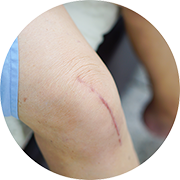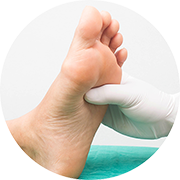

What could it be?
Nerve Pain
What Is Neuropathic Pain?
Neuropathic or nerve pain (NP) is a long-term or chronic pain disease that results from nerve damage. It can be caused by different diseases or conditions. In Ireland, 54% of nerve pain sufferers surveyed said their pain was severe1. Neuropathic or nerve pain may affect larger areas of the body or it can be restricted to a smaller area, in this case it is called localised neuropathic pain (LNP)2.
What Causes Neuropathic Pain?
Neuropathic or nerve pain may occur in the absence of an obvious visible cause (e.g. an accident, an injury, a chemical burn). There are several external situations that can directly damage nerves and lead to neuropathic pain, such as:
- Amputation of a limb (phantom pain, stump pain)
- Surgery (scar pain, post-surgery pain)
- Trauma or accident
Neuropathic pain is also a common complication of other diseases, including nerve damage after shingles or herpes zoster infection (postherpetic neuralgia or PHN), nerve damage after HIV infection, nerve damage resulting from diabetes mellitus (diabetic polyneuropathy or DPN), multiple sclerosis, or nerve damage in the spine or lower back (lower back pain).
What Are the Typical Neuropathic Pain Symptoms?
Neuropathic pain is a chronic pain condition often described by patients with symptoms such as 'shooting pain', 'burning pain', or 'stabbing pain'. It can also feel like 'pins and needles'. In addition, neuropathic or nerve pain patients can suffer from symptoms such as allodynia (when a normally unpainful stimulus such as a light touch or clothing becomes painful) and hyperalgesia (when a mild or moderate stimulus causes severe pain).4
How Is Neuropathic Pain Diagnosed?
Neuropathic pain is often difficult to diagnose and is often under-diagnosed or mis-diagnosed3. This can lead to patients with neuropathic or nerve pain being insufficiently treated on a 'trial and error' basis that may persist over many months or even years. This lack of diagnosis and treatment also contributes to the fact that 49% of Irish chronic pain sufferers have missed up to a week of work in the last year due to their pain1. A correct and early diagnosis is crucial to find the right treatment and to relieve symptoms of nerve pain. It is therefore important that patients describe their symptoms in as much detail as possible to their doctor. As part of this process, the doctor will conduct a physical examination and ask about the medical history of the symptoms.
What Can You Do?
There are treatment options available. It is important to see your healthcare professional for further advice regarding your condition. Do you have symptoms that you would describe as 'burning pain', 'shooting pain', or 'stabbing pain'? Do you have sensitive skin and/or feel a sensation like 'pins and needles' on the skin?
If you have chronic pain and think that it might be neuropathic or nerve pain, please fill out the 'mypainfeelslike... questionnaire' and make an appointment to see your doctor. It is a very useful tool to facilitate you in communicating more effectively with your doctor, as it supports the doctor in making an accurate diagnosis of the cause of chronic pain. It will be most useful for you to accurately describe your chronic pain, where it occurs on your body and if it is triggered by anything in particular. In preparation for a doctor's appointment, patients should thoughtfully complete the 'mypainfeelslike... questionnaire', print out the results, and discuss them with their doctor. You can read more about possible treatment options here
Other kinds of pain
-
References
1. Survey by Empathy Research on behalf of Grunenthal based on 501 Irish sufferers of chronic pain aged 18+ in January 2016.
2. Mick G., et al (2012). What is localized neuropathic pain? A first proposal to characterise and define a widely used term. Pain Manage 2(1), 71-77.
3. May S., et al (2009). Diagnosis and assessment of neuropathic pain. F1000 med reports, 2009. 1: 76.
4. Woolf C., et al (1999). Neuropathic pain: Aetiology, symptoms, mechanisms, and management. Lancet; 353:1959-64









